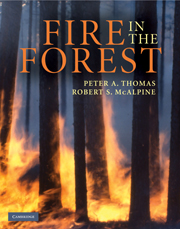Book contents
- Frontmatter
- Contents
- Preface
- List of contributors
- 1 In the beginning
- 2 Historical review
- 3 How a fire burns
- 4 Fire in the wild landscape
- 5 Fire ecology
- 6 The benefits of fire and its use as a landscape tool
- 7 Fire suppression
- 8 Wildland fire and its management – a look towards the future
- Further reading
- References used in the text
- Index
6 - The benefits of fire and its use as a landscape tool
Published online by Cambridge University Press: 05 August 2012
- Frontmatter
- Contents
- Preface
- List of contributors
- 1 In the beginning
- 2 Historical review
- 3 How a fire burns
- 4 Fire in the wild landscape
- 5 Fire ecology
- 6 The benefits of fire and its use as a landscape tool
- 7 Fire suppression
- 8 Wildland fire and its management – a look towards the future
- Further reading
- References used in the text
- Index
Summary
Fire and biodiversity – an overview
The region within the European Union classified in the Habitats Directive under category 90 ‘Forests of Boreal Europe’ is but a fraction of an immense biogeographical zone that stretches east, covering over 700 million hectares of Siberia, and that continues on in a vast swathe through northern North America and Canada. Russia alone supports 22% of the world's forests and between 70–75% of this area remains close to natural. The ‘Taiga’, as it is also known, is large in nearly all senses of the word; the size of habitats, including mires, lakes and rivers that nest within it; the large, roaming herds of big game; the size of the big animals, including moose and brown bear; and not least of all, the scale of disturbances and processes that give this ecosystem its distinctive character. To most who know it, the boreal biome remains one of the last frontiers of wilderness, a ‘self-willed’ land shaped by the forces of wind, snow, pathogens, herbivores and especially fire.
South of the equator, on the African continent, stretching 2500 km from east to west and 1250 km north to south, lies one of the greatest expanses of uniform vegetation in Africa, the Miombo Forest. This landscape of trees and grass, sometimes dense uniform forest, is dominated by trees belonging to the genera Brachystegia and Julbernadia.
- Type
- Chapter
- Information
- Fire in the Forest , pp. 119 - 148Publisher: Cambridge University PressPrint publication year: 2010
- 1
- Cited by

